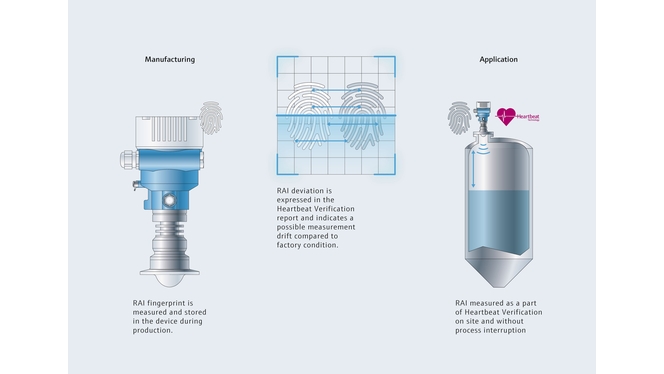校准周期取决于过程的重要性和测量仪表的长期稳定性。执行仪表校准必须中断过程,需要破坏仪表上的密封部件,导入标准液。新一代质量流量计具有高可靠性,校准周期可达两年,甚至更长。然而延长校准周期后,期间随机故障无法被及时检出的风险也随之增大。
关键点
20%
仅有20%的仪表设备设置了理想的校准周期
优化仪表标定,确保cGMP合规

带液标定与心跳自校验功能双剑合璧
心跳自校验功能通过第三方独立机构的TÜV测试和认证,符合DIN EN ISO3标准的各项要求,兼容传统带液标定,支持溯源仪表功能检查。可靠性显著提高,两次校准操作间的不确定度明显降低。同传统带液标定相比,心跳自校验无需耗费过程介质,借助冗余内部参比测量验证仪表的各项功能。
我们掌握专业知识
原始工厂标定确定基准值,数值永久保存在流量计的非易失性安全储存单元内,并记录在出厂文件上。现场执行心跳自校验,比对测试数据和基准值,从而检测出仪表内置电子部件的漂移或机械退化状况。关键电子线路采用冗余设计,能够可靠检测出硬件故障。
- 同带液标定相比较,配备心跳自校验功能的测量仪表,比如 Promass 100/300/500科里奥利质量流量计能够节省80%以上的时间,有效延长了校准周期。
- 您是否有兴趣继续了解Heartbeat Technology心跳技术如何通过监管审计?阅读白皮书《Heartbeat Technology心跳技术的权威解读》" ,了解如何在GMP生产过程中运用在线仪表校验技术。

借助Heartbeat Technology心跳技术,延长校准周期
采用Heartbeat Technology心跳技术的测量仪表可以长期可靠输出稳定的测量值。在大多数情况下,仪表校准频次大幅降低,且不会破坏合规性。湿标次数减少,校准成本降低,提高了设备综合效率(OEE),进而提升了工厂可用性。
我们掌握专业知识
缩短了仪表校准所需的生产中断时间,减少了计划外停车事故的发生频次,有助于提高生产效率,实现卓越运营。可靠的测量数据,保证两次校准操作之间过程值正确,有效降低了产品质量风险,助力达成患者用药安全的目标。
- Micropilot FMR63B借助心跳技术雷达精度指标延长校准周期,在不中断生产过程的条件下验证雷达的物位测量精度。
- iTHERM TM371是Endress+Hauser首台自标定热电阻温度计,全自动执行在线自标定。这一专利技术已经通过众多实验室和现场应用的测试和验证。详细信息请阅读白皮书。
- 您希望进一步了解Heartbeat Technology心跳技术等类似技术如何减小,甚至完全取代湿标操作吗?阅读白皮书《过程仪表的质量源于设计》。

仪表校准简单快速
心跳自校验操作简单,执行快速。既无需停用仪表,也无需中断过程。仪表能够始终稳定输出测量结果。心跳自校验过程仅耗时30秒,非常快速。人们可以在安全的远程控制室内启动心跳自校验,比如每天执行一次,或在每个批次开始前执行一次。每次执行完仪表校验,都会生成一份完整的心跳自校验报告。
我们掌握专业知识
报告为防篡改的PDF文件,保存在仪表内,可轻松查询访问。支持各类资产管理系统或内置网页服务器下载。借助心跳自校验功能,在生命周期内都可提供仪表测试记录,完全可溯源,且符合审计要求,方便检查。
优势
采用心跳技术的测量仪表可以在长期运行过程中输出稳定可靠的测量结果。心跳自校验功能在保证合规性不受影响的前提下显著减少带液标定的次数。减少仪表校准次数,有助于提高设备综合效率,提升工厂可用性。可靠的测量数据,保证两次校准操作之间过程值正确,有效降低了产品质量风险。
关键点
1.5小时
每次仪表校验可节省1.5小时
关键点
500 - 1000 欧元
年均节省500至1000欧元仪表校准开支,因仪表而异
我们为您提供服务支持
Endress+Hauser提供自校验技术,比如Heartbeat Technology心跳技术,确保两次仪表校准操作间隔时间内过程安全,TÜV认证确认该技术适合监管要求更严格的行业应用。Heartbeat Technology心跳技术提高了可用性和测量点的可靠性,这只是推动生命科学行业用户优化校准程序的众多优势中的两个。带液标定结合心跳自校验功能,为您提供支持:
- 降低仪表校准频次,延长带液标定周期
- 提高两次带液标定间隔时间内的测量结果可信度
- 符合ISO 9001标准的溯源要求 —— 通过第三方认证
- 确保测量精度,无需中断过程










